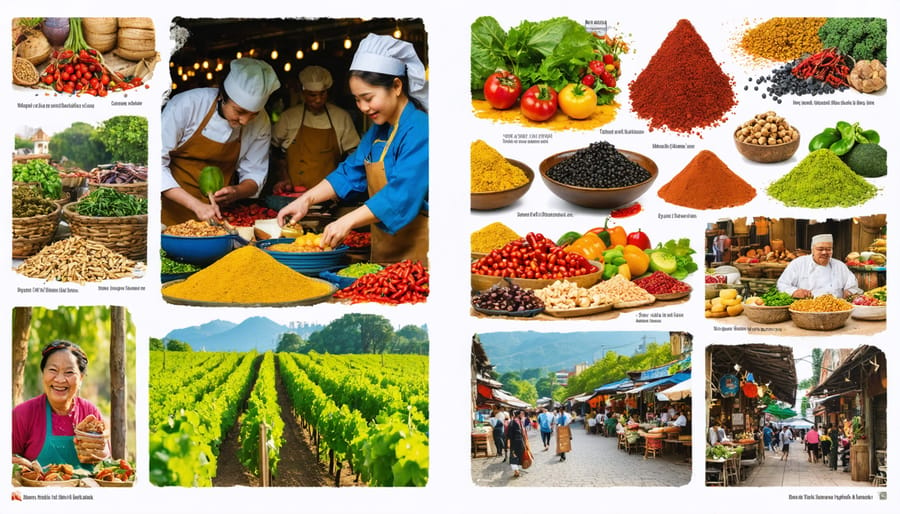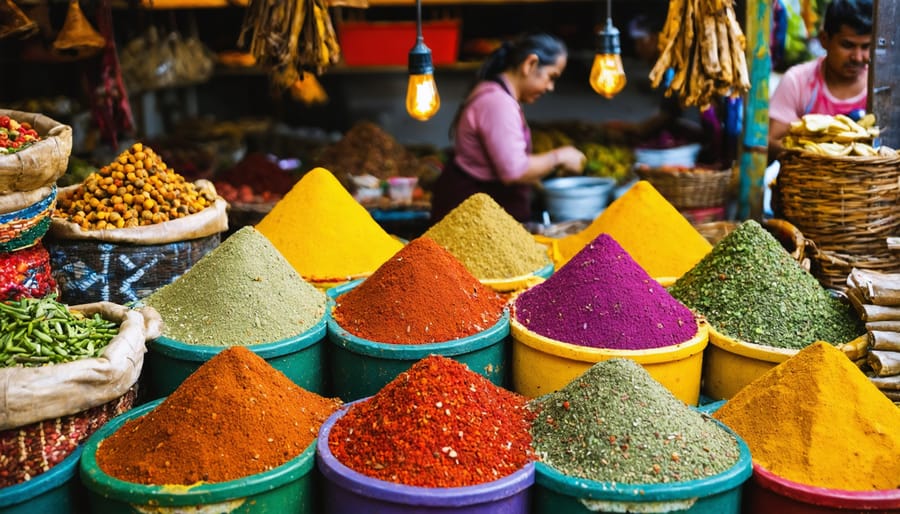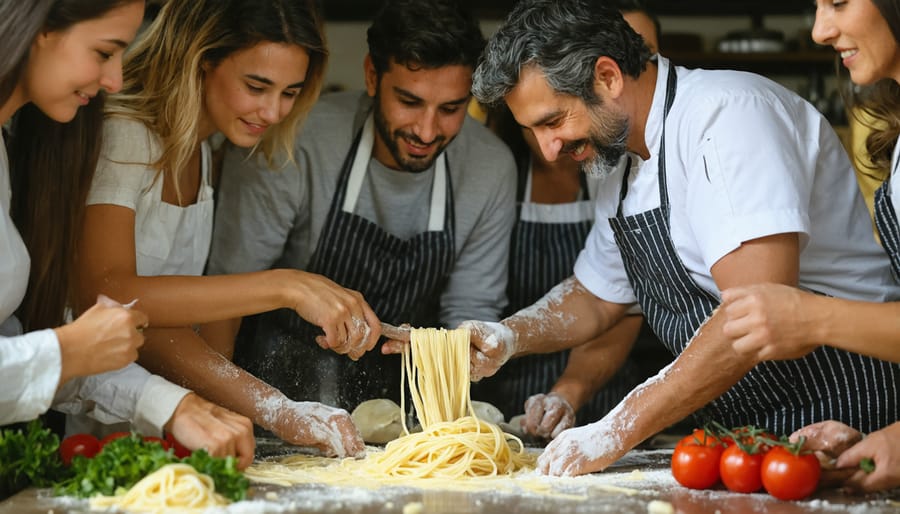
Imagine stepping into a bustling night market in Bangkok, where the sizzle of street food mingles with fragrant steam rising from countless woks, or wandering through a sun-drenched vineyard in Tuscany, learning the secrets of generations-old pasta recipes. This is the world of a culinary explorer – someone who travels not just to see new places, but to taste, learn, and immerse themselves in the authentic flavors that tell the story of each destination.
Being a culinary explorer means going beyond the typical tourist experience, diving fork-first into local food cultures that reveal the heart and soul of a place through its cuisine. It’s about connecting with local chefs, learning traditional cooking techniques, and understanding how geography, history, and culture shape what appears on the plate. Whether you’re sampling street food in Mexico City, joining a cooking class in Marrakech, or foraging for ingredients in the Nordic wilderness, each culinary adventure becomes a chapter in your own gastronomic story.
For those who believe that the best travel memories are made around a table, culinary exploration offers a unique lens through which to view the world – one bite, one recipe, and one shared meal at a time.
What Makes a True Culinary Explorer?
Beyond Restaurant Hopping
True culinary explorers know that authentic food experiences extend far beyond restaurant tables. They seek out local markets, where vendors share stories about generations-old recipes and traditional ingredients. They join cooking classes in family homes, learning to make pasta from an Italian nonna or master the art of making kimchi in a Korean household.
Many dedicated food adventurers also participate in agricultural experiences, from olive harvesting in Greece to truffle hunting in France. They visit small-batch producers, learning how local cheese, wine, or chocolate is made. Some even arrange stays with farming families to understand the complete journey from field to plate.
The most rewarding experiences often come from building connections with local food communities. This might mean joining a community feast during a festival, helping prepare meals at a neighborhood gathering, or spending time with street food vendors to learn their craft. These immersive experiences not only deepen your understanding of local cuisine but also create lasting memories and meaningful cultural exchanges that go far beyond simply tasting the food.
The Art of Food Connection
Food has an incredible power to bring people together, transcending language barriers and cultural differences. As a culinary explorer, sharing food experiences becomes more than just a way to satisfy hunger – it’s about creating meaningful connections that last a lifetime.
Whether you’re breaking bread with locals in a Tuscan village or swapping recipes with fellow travelers in a Bangkok cooking class, food becomes the universal language that opens doors to authentic cultural exchanges. I’ve witnessed countless friendships blossom over steaming bowls of pho in Vietnam and animated discussions about secret family recipes in Greek tavernas.
The beauty of culinary exploration lies in these shared moments: the laughter when attempting to perfect your first handmade pasta, the stories exchanged while sipping traditional chai, or the pride in a local vendor’s eyes as they introduce you to their signature dish. These connections transform ordinary meals into extraordinary memories, creating a tapestry of relationships woven together by the common thread of food appreciation.
By embracing the role of a culinary explorer, you’re not just collecting recipes – you’re collecting stories, building bridges, and creating a global community united by the love of good food.
Planning Your Culinary Adventure
Research Like a Food Detective
Being a food detective is one of the most rewarding aspects of culinary exploration. Just like incorporating mindful cooking practices in your kitchen, discovering authentic local food experiences requires patience and attention to detail.
Start by following the locals, not the tourists. I’ve found some of my favorite hidden gems by visiting markets during early morning hours when restaurant chefs do their shopping. These moments offer glimpses into the real food culture of a place, from the freshest ingredients to time-honored preparation methods.
Social media can be your secret weapon, but look beyond the obvious hashtags. Follow local food bloggers, chefs, and market vendors in your destination. They often share insider tips about upcoming food festivals, pop-up events, or family-run establishments that tourists might miss.
Don’t be afraid to venture into residential neighborhoods. Some of my most memorable meals have come from tiny restaurants tucked away in apartment buildings or family-owned cafes where the menu is handwritten daily. Look for places where elderly locals gather for morning coffee or where workers crowd during lunch hours – these are usually signs of authentic, quality food.
Ask specific questions when seeking recommendations. Instead of “Where’s good to eat?” try “Where would your grandmother go for the best traditional soup?” This approach often leads to more meaningful suggestions and helps break through the tourist-targeted recommendations.
Remember, sometimes the most authentic experiences aren’t picture-perfect. That tiny storefront with plastic chairs might serve the most incredible street food you’ve ever tasted. Trust your instincts, be open to adventure, and always carry a notebook to document your discoveries.

Making Meaningful Connections
Making meaningful connections through food is easier than ever, thanks to the growing number of platforms and resources available to culinary enthusiasts. One of the best ways to dive deep into cultural food traditions is by connecting with local experts who are passionate about sharing their knowledge and stories.
Start by exploring cooking class platforms like Airbnb Experiences, Cookly, or local culinary schools in your destination. These often offer intimate, hands-on experiences where you can learn authentic recipes while chatting with local chefs about their food heritage. I’ll never forget learning to make fresh pasta in a tiny Tuscan kitchen, where our host shared stories about her grandmother’s secret recipe techniques!
Food tours are another fantastic way to connect with fellow food lovers. Look for small-group tours led by local guides who can introduce you to hidden gems and family-run establishments. Sites like Eating Europe and WithLocals are great starting points, offering carefully curated experiences that go beyond typical tourist spots.
For a more personal touch, consider platforms like EatWith or VizEat, where local hosts welcome you into their homes for authentic dining experiences. These intimate gatherings often lead to lasting friendships and deeper cultural understanding. Pro tip: Read reviews carefully and book hosts who share detailed descriptions of their experiences – it shows their commitment to creating meaningful connections.
Don’t forget to join local food-focused Facebook groups or follow regional food bloggers before your trip. They often share insider tips and might even be open to meeting up to share their favorite local spots!

Bringing the Experience Home
Your Global Kitchen
Transform your kitchen into a vibrant hub of global flavors by thoughtfully curating tools and ingredients from your culinary adventures. As a culinary explorer, your kitchen should tell the story of your journeys while remaining functional and inspiring. Start by designating a special shelf or corner for your travel-sourced treasures – perhaps that hand-carved wooden spoon from Thailand or that perfectly seasoned tagine from Morocco.
When it comes to sourcing global ingredients, think beyond the obvious spices and condiments. Consider incorporating unique cooking vessels, authentic serving pieces, and local kitchen tools that bring traditional cooking methods into your home. I’ll never forget discovering my beloved bamboo steamer in a tiny shop in Hong Kong – it’s now an essential part of my dim sum adventures at home.
Create a practical storage system that showcases your international collection while keeping everything accessible. Clear jars for spices, labeled with both English and native names, add both functionality and educational value. Display colorful ceramics from Mexico or hand-painted plates from Portugal as both decor and serving pieces. Remember to maintain a balance between collecting special items and ensuring your kitchen remains a workable space where you can create and experiment with global cuisines.

Sharing Your Food Stories
One of the most rewarding aspects of being a culinary explorer is sharing your food adventures with others. Hosting travel-inspired dinner parties lets you recreate those magical moments from your journeys while creating new memories with friends and family.
Start by choosing a destination theme that resonates with your travels. Whether it’s a vibrant Mexican fiesta or an intimate Italian dinner, set the mood with appropriate music, decor, and table settings. I love using photos from my trips as conversation starters and incorporating authentic serving pieces I’ve collected along the way.
Consider hosting a cooking session before the main event. Teaching friends how to make fresh pasta just like you learned in Bologna, or sharing the secret to perfect pad thai from your Bangkok cooking class, creates an interactive experience that’s both fun and educational. Don’t worry about everything being perfect – the joy is in the shared experience and stories.
Document your gathering through photos and encourage guests to participate in the cooking process. Create recipe cards with your travel anecdotes for guests to take home. You might even start a monthly supper club where each member shares their own culinary travel experiences.
Remember, these gatherings aren’t just about the food – they’re about creating connections and inspiring others to embark on their own culinary adventures. Share your mishaps along with your successes; sometimes the best stories come from when things didn’t go quite as planned.
Embracing the role of a culinary explorer enriches our lives in ways that extend far beyond the dinner table. Each time we venture into a new cuisine or cooking technique, we’re not just feeding our bodies – we’re nourishing our souls with stories, traditions, and connections that span cultures and generations.
Whether you’re wandering through a vibrant market in Morocco or discovering a hidden gem of a restaurant in your own neighborhood, these food-focused adventures create memories that last a lifetime. They teach us to be more curious, more open-minded, and more appreciative of the diverse ways people around the world express themselves through food.
Even when we can’t travel far, bringing that explorer’s mindset into our own kitchens can transform everyday cooking into an exciting journey. Try that recipe you’ve been curious about, strike up a conversation with the vendor at your local farmers’ market, or host a dinner party featuring dishes from a country you dream of visiting.
Remember, being a culinary explorer isn’t just about seeking new flavors – it’s about embracing the joy of discovery and letting food be your guide to understanding both the world and yourself better.



